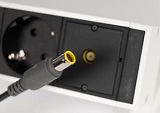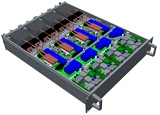»eMobiGrid« Joint Project
The project partners in eMobiGrid are working on a comprehensive energy infrastructure that supports the efficient integration of sustainable energy sources and facilitates the further development of electromobility. As a solution, the focus in eMobiGrid is on local and decentralized DC grids. These enable low-loss coupling of renewable energy sources and battery storage and are suitable for the integration of charging stations for different types of electric vehicles. The key components within these DC grids are efficient, reliable and safe DC/DC converters.
In eMobiGrid, the DC Grids group at the IISB is developing a particularly flexible, insulating DC/DC converter. Due to its ultra-wide voltage range, this converter is specifically optimized for bidirectional DC charging. This means that, in addition to passenger cars, commercial vehicles can also be charged and discharged. Bidirectional charging allows the batteries of electric vehicles to be used as intermediate storage in the DC grid. In this way, they buffer the overproduction of renewable energies. The bidirectional charging technology is therefore particularly important for grid stability when the energy supply fluctuates
Project Partners: Richter R&W Steuerungstechnik GmbH, eCharge Hardy Barth GmbH, EnQs gmbH, Lehrstuhl Mess- und Regeltechnik (MRT) (University Bayreuth)
Funding: eMobiGrid is funded by the German Federal Ministry for Digital and Transport (BMDV) within the framework of the "BMDV Electric Mobility Funding Guideline" with approximately three million euros. The funding program is coordinated by NOW GmbH and implemented by Projektträger Jülich (PtJ).
Press Release: Published on 17/05/2023 in German
 Fraunhofer Institute for Integrated Systems and Device Technology IISB
Fraunhofer Institute for Integrated Systems and Device Technology IISB

